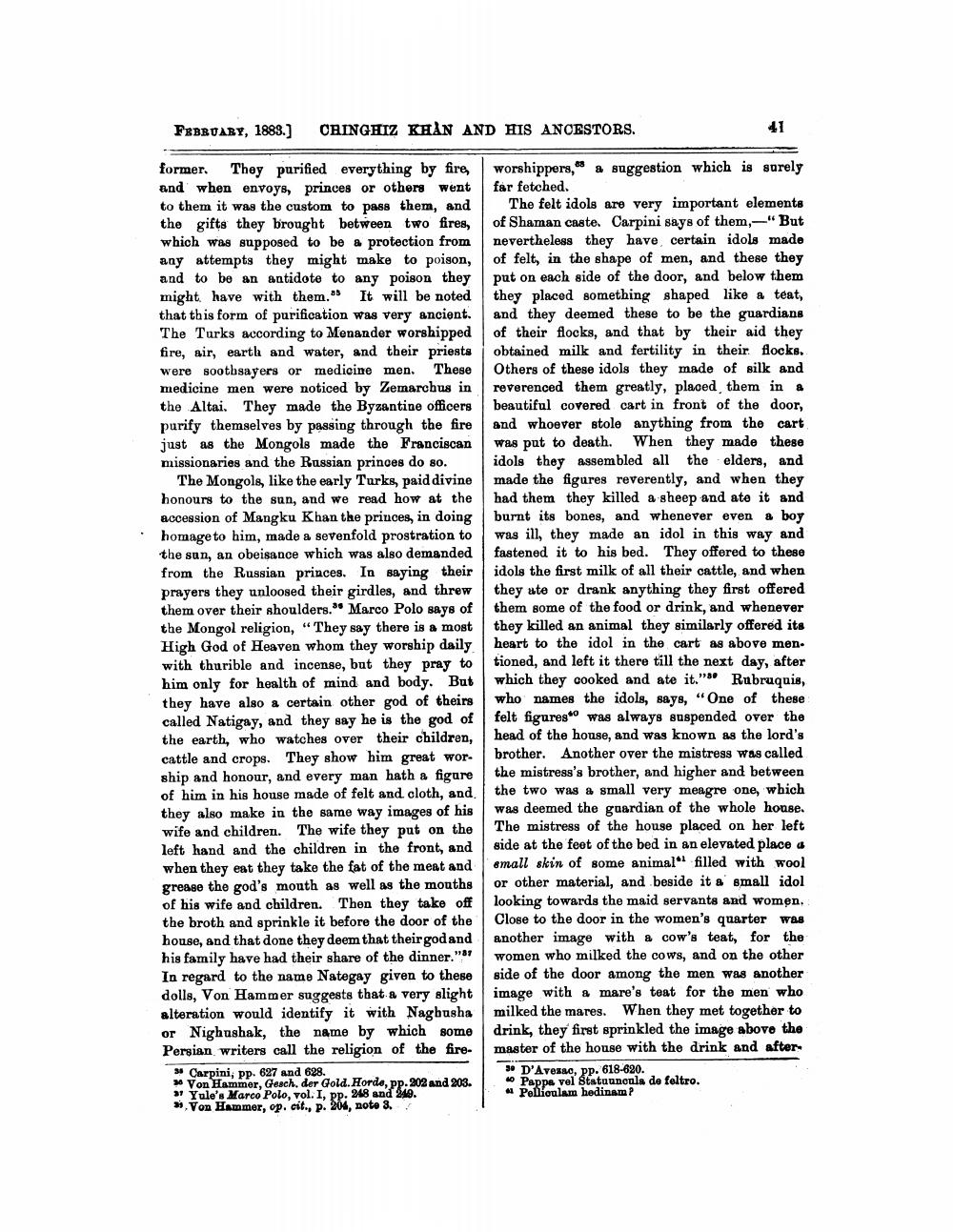________________
FEBRUARY, 1883.]
CHINGHIZ KHAN AND HIS ANCESTORS.
former. They purified everything by fire, and when envoys, princes or others went to them it was the custom to pass them, and the gifts they brought between two fires, which was supposed to be a protection from any attempts they might make to poison, and to be an antidote to any poison they might have with them. It will be noted that this form of purification was very ancient. The Turks according to Menander worshipped fire, air, earth and water, and their priests obtained milk and fertility in their flocks..
The felt idols are very important elements of Shaman caste. Carpini says of them,-" But nevertheless they have certain idols made of felt, in the shape of men, and these they put on each side of the door, and below them they placed something shaped like a teat, and they deemed these to be the guardians of their flocks, and that by their aid they
were soothsayers or medicine men. These medicine men were noticed by Zemarchus in the Altai. They made the Byzantine officers purify themselves by passing through the fire just as the Mongols made the Franciscan missionaries and the Russian princes do so.
Others of these idols they made of silk and reverenced them greatly, placed them in a beautiful covered cart in front of the door, and whoever stole anything from the cart. was put to death. When they made these idols they assembled all the elders, and made the figures reverently, and when they had them they killed a sheep and ate it and burnt its bones, and whenever even a boy was ill, they made an idol in this way and fastened it to his bed. They offered to these idols the first milk of all their cattle, and when they ate or drank anything they first offered them some of the food or drink, and whenever they killed an animal they similarly offered its heart to the idol in the cart as above men. tioned, and left it there till the next day, after
"530
The Mongols, like the early Turks, paid divine honours to the sun, and we read how at the accession of Mangku Khan the princes, in doing homage to him, made a sevenfold prostration to the sun, an obeisance which was also demanded from the Russian princes. In saying their prayers they unloosed their girdles, and threw them over their shoulders." Marco Polo says of the Mongol religion, "They say there is a most High God of Heaven whom they worship daily with thurible and incense, but they pray to him only for health of mind and body. But they have also a certain other god of theirs called Natigay, and they say he is the god of the earth, who watches over their children, cattle and crops. They show him great wor ship and honour, and every man hath a figure of him in his house made of felt and cloth, and. they also make in the same way images of his wife and children. The wife they put on the left hand and the children in the front, and when they eat they take the fat of the meat and grease the god's mouth as well as the mouths of his wife and children. Then they take off the broth and sprinkle it before the door of the house, and that done they deem that their god and his family have had their share of the dinner.""" In regard to the name Nategay given to these dolls, Von Hammer suggests that a very slight alteration would identify it with Naghusha or Nighushak, the name by which some Persian writers call the religion of the fire
which they cooked and ate it." Rubruquis, who names the idols, says, "One of these felt figures was always suspended over the head of the house, and was known as the lord's brother. Another over the mistress was called the mistress's brother, and higher and between the two was a small very meagre one, which was deemed the guardian of the whole house. The mistress of the house placed on her left side at the feet of the bed in an elevated place a small skin of some animal filled with wool or other material, and beside it a small idol looking towards the maid servants and women. Close to the door in the women's quarter was another image with a cow's teat, for the women who milked the cows, and on the other side of the door among the men was another image with a mare's teat for the men who milked the mares. When they met together to drink, they first sprinkled the image above the master of the house with the drink and after
3 Carpini, pp. 627 and 628.
30 Von Hammer, Gesch. der Gold. Horde, pp. 202 and 203. 37 Yule's Marco Polo, vol. I, pp. 248 and 249.
Von Hammer, op. cit., p. 204, note 3.
41
worshippers," a suggestion which is surely far fetched.
30 D'Avezac, pp. 618-620.
60 Pappa vel Statuuncula de feltro. Pelliculam hedinam?




